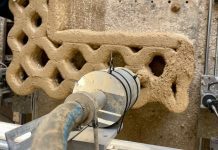
Researchers at the University of Sydney, in collaboration with start-up Dewpoint Innovations, have developed a nanoengineered polymer coating that can passively cool buildings and collect water from the air without using energy.
The innovation could have applications in manufacturing, urban infrastructure, and water management, the university said in a news release.
The University of Sydney led the research, which was conducted on the roof of the Sydney Nanoscience Hub and published in Advanced Functional Materials.
The coating, created by a team led by Professor Chiara Neto from the University of Sydney Nano Institute and School of Chemistry, reflects up to 97 per cent of sunlight and radiates heat into the air, keeping surfaces up to six degrees cooler than the surrounding environment under direct sunlight. This cooling reportedly enables atmospheric water vapour to condense on the surface, allowing it to be collected.
Professor Neto said the technology could provide low-cost, decentralised sources of fresh water and advance the development of cool roof coatings.
“This technology not only advances the science of cool roof coatings but also opens the door to sustainable water sources, a critical need in the face of climate change and growing water scarcity,” she said.
During a six-month trial conducted by University of Sydney researchers, dew could be collected on 32 per cent of days, with up to 390 millilitres of water per square metre harvested under optimal conditions.
According to the study, a 12-square-metre surface could supply the daily drinking needs of one person.
The university said the coating is made of polyvinylidene fluoride-co-hexafluoropropene (PVDF-HFP) and achieves high reflectivity through its porous internal structure, rather than using ultraviolet-reflective pigments.
Dr Ming Chiu, lead author of the study and Chief Technology Officer of Dewpoint Innovations, said the design provides durable performance without the environmental drawbacks associated with pigment-based coatings.
The technology could also help reduce urban heat island effects and lower energy demand for cooling. Professor Neto, also a member of the University of Sydney Net Zero Institute, noted that dew collection can occur in both humid and arid conditions, suggesting it could supplement existing water sources rather than replace them.
Dewpoint Innovations, which licensed the technology from the University of Sydney in 2022, is developing a water-based paint formulation that can be applied using standard rollers or sprayers.
Perzaan Mehta, CEO of Dewpoint Innovations, said the solution is scalable and energy-free, potentially turning rooftops and remote infrastructure into reliable sources of clean water.
Professor Neto emphasised the University of Sydney’s role in developing the technology. “Imagine roofs that not only stay cooler but also make their own fresh water – that’s the promise of this research conducted here at the University of Sydney,” she said.


















